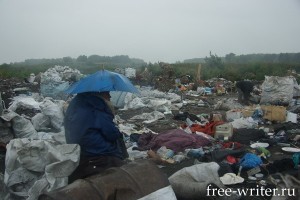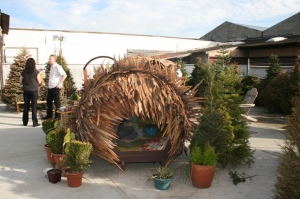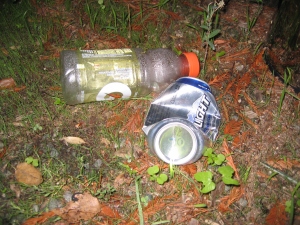People live on dumps in many places in the world, and I’m sure they would do so in the United States if it weren’t for a couple of simple facts:
> Our landfills bury the treasure as soon as it arrives, so it’s hard to make a living on the dump. You would have to dig surreptitiously, after nightfall, as a kind of latterday Penelope slyly undoing at night the progress made by day by the bulldozers covering up our gluttonies.
> Landfills in this country have gates and fences. Whether to keep out the homeless, keep out donations for which no fee is paid, or keep out witnesses to unlawful practices, I do not know. There are easier ways to get to the gold besides storming the dump.
> The most easily recycled materials are, in various places, obediently sorted by householders and presented for removal on the eve of collections every week. Some people travel the collection route before the official truck comes by and stay a lot cleaner than the folks who pull out the goodies on a dump. (Note: New York City has made this a crime, punishable by a stiff fine and forfeiture of vehicle if committed by motorized transport. If committed by shopping cart, you lose your gleanings, I think, but you get to keep your wheels. I’m of course not suggesting anyone should do this.)

Photo by Olga Saly
Such deterrents from scavenging on the dump apparently don’t exist in Russia, as witness this blog entry: Castles in the Country: Refuge from Everyday Life. Actually, I made that title up, because Google Translate delivers something that only vaguely resembles English. Perhaps the original title speaks of refugees from everyday life, which would be a little more charitable.
My friend Nina, who can actually read the original, sums up the piece as follows: “The author’s intent is not to describe the garbage/recycling problem in Russia, but to share her shocking discovery that some (Russian) people actually live at dumps. In the end she concludes that these people chose to live at this dump and this is their own choice and nobody else’s fault.”
Nina speculates that the dump is in Novosibirsk, Siberia. I looked it up on the map, and I’m thinking it must get very cold there in the winter. Some gleaners come to work every day, looking for recyclables, which they sell to the “master,” a middleman who presumably resells the booty to recycling outfits. One of those workers is a 29-year-old woman, who has a husband with a regular job and a little boy whom she has started leaving at home ever since he got buried under a pile of trash. A few others live at the dump, a circumstance that works in their favor, because they don’t have to commute. They can get down to work first thing in the morning and get first dibs. They don’t seem to leave the dump at all, finding food enough to eat at work. The vodka delivery service brings the more important staple of their diet right to their door, if they have one, much as my grandfather used to deliver milk.
I’ve written about scavenging before (see scavenging, how the other half used to live, and saucepans, bonnets and umbrellas). I started out thinking this was a simple issue. Gleaning, recycling and scavenging, formally or informally—it’s all good in principle, a fact that is daily becoming more obvious. At the same time, nobody should have to live or work under conditions that are likely to cause illness or injury. I believe there are sufficient resources in the world to go around, even for the vast numbers of people who currently inhabit the earth. I’m convinced it is unnecessary for anyone to live on the dump. I would like to be able to vote for people who actually have some idea of working towards a more just sharing of resources. Instead of going to Vegas and giving my extra earnings to the filthy rich, I try to give money to organizations already embarked on the effort. In small ways, I look out for opportunities to share, and I try to refrain from judgments of people whose story I don’t know. Straightforward enough, I thought.
But I got some interesting comments on earlier posts–about the manipulative nature of pictures appearing with some regularity in the newspapers–about the question of what you are to do in the face of the misery pictured and described–about the invitation to just feel superior or perhaps even to blame the victims. Food for thought.
I think we are probably programmed to want to do something to fix what is obviously not right. If you see a baby drowning in a pond, you jump in to pull it out. If you see people looking for food on the dump, you know just as intuitively that you are supposed to do something. But what? Pulling something out of a dump isn’t as straightforward as dragging a baby ashore and returning it to its rightful owner. It’s not like you can give these people back to their mother. Besides when you see a picture in the newspaper, doing something is pretty much ruled out altogether. Instead, it’s easy to feel guilty. Either that or you have to tell yourself a story about why you don’t have to care.
Face to face, I suspect, people who live on the dump are likely not very clean and otherwise very scary. I base this estimate on my exposure to the homeless in San Francisco, who are not very clean and for the most part very scary. I must confess I have racked my brain many times for a route from my parking lot to my client’s offices that doesn’t lead straight through the “dorms” under the bus terminal overpasses downtown. It really is hard to see them and feel powerless to change their predicament. It’s a signficant tax, much more onerous frankly than an extra few % would be.
And that brings me back to the beginning. I’m convinced such extremes of poverty as life on the dump is a systemic problem, for which I’m not personally responsible, and which I cannot personally solve, but with which I am complicit to some extent just because I have been lucky. I have fared well. In the uneven division of resources that rules our world, I came up roses. Compared to the wealthiest, I’m a poor slob. Compared to the mass of humanity, I’m exceedingly well-off. The least I can do, it strikes me, is be happy. And the next logical step is to scale back, to cut out any consumptive bloat from my own lifestyle, to work against the competitive consumption that says resources must be unevenly divided for happiness to ensue.
One closing thought: I’d like to live in a society that has a social contract–some sense that we are all in it together, some sense of mutual responsibility, some idea that everybody needs to be taken care of, long before anyone ends up on the street, unemployable, angry, deranged, hungry, and addicted. Or on the dump, with a special liquor delivery to accommodate the agoraphobic.
—-

Berdsk, near Novosibirsk, in Siberia
Postscript: A friend enlightened me regarding the location of this landfill. It is not in Novosibirsk but in nearby Berdsk—across a little tendril of water sticking out from Novosibirskoye Lake like a raggedy tail.







